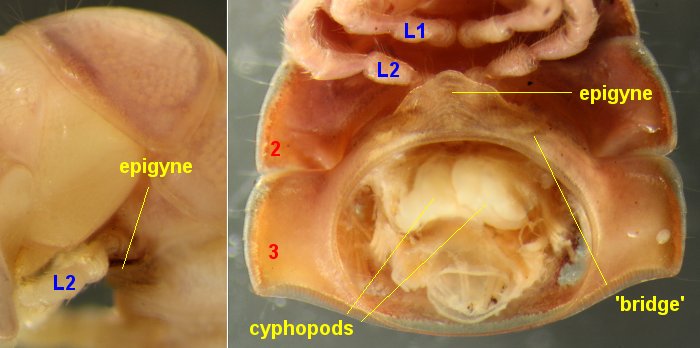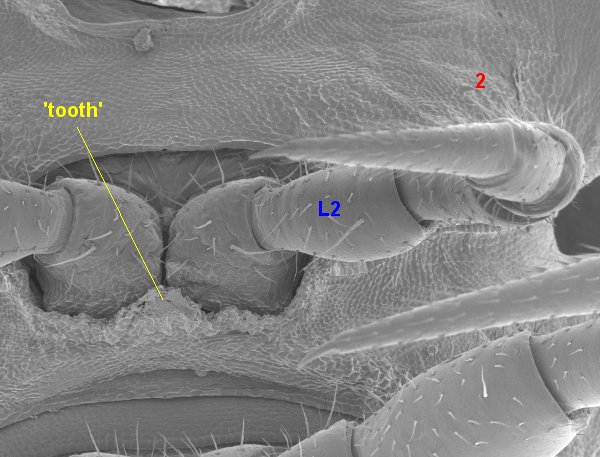Back to: gonopods
Forward to: mating
Cyphopods

Left: Female Lissodesmus hamatus (Dalodesmidae), Tasmania
Right: Female Tasmanopeltis grandis (Dalodesmidae), Tasmania
Posteroventral view of ring 3
The cyphopods (image above, right) are a pair of sacs inside ring 3 in adult female Polydesmida. They are also sometimes called vulvae (singular vulva). They store sperm after mating and connect to the rest of the female reproductive system. The cyphopods are not visible externally*, and access to them is through a narrow ventral opening on ring 3. The opening is between the sternite supporting legpair 2, and a 'bridge' which completes the ring and is formed by the ring 3 pleurites. The anterior margin of the 'bridge' (= the posterior edge of the ventral opening), is called the epigyne (images above and below).

Female Tasmaniosoma armatum (Dalodesmidae), Tasmania
Ventral view of ring 3
The epigyne is often raised above the surface of ring 3 (i.e., it extends ventrally) and its shape is variable. In the Dalodesmidae shown above and many other species, its centre extends as a rounded-triangular 'tooth'. The epigyne can also be 'two-toothed', rectangular or trapezoidal, with or without a sculptured edge.
Cyphopods have been carefully studied by Polydesmida specialists to see if they might be useful in identifying and classifying Polydesmida. The answer so far is 'not often'. A European study of 29 Polydesmida species in six genera (Tadler and Thaler 1993) also found within-species variations in the epigyne:
Als ausserordentlich variabel erwies sich allerdings die Querleiste der Ventralspange von P. [Polydesmus] subterraneus: diese war selbst innerhalb einer Population einteilig-tafelförmig bis zweigeteilt ausgebildet.
The transverse margin of the ventral bridge of P. [Polydesmus] subterraneus certainly proved to be unusually variable: within a single population it took the form of a one-part or a two-part plate.
*When an adult female is killed and preserved in alcohol, or is distended after drowning in water, the cyphopods sometimes emerge from their cavity and extend ventrally.
Tadler, A. and Thaler, K. 1993. Genitalmorphologie, Taxonomie und geographische Verbreitung ostalpiner Polydesmida (Diplopoda: Helminthomorpha). Zoologische Jahrbücher, Abteilung für Systematik, Geographie und Biologie der Tiere 120: 71-128.
Back to: gonopods
Forward to: mating
